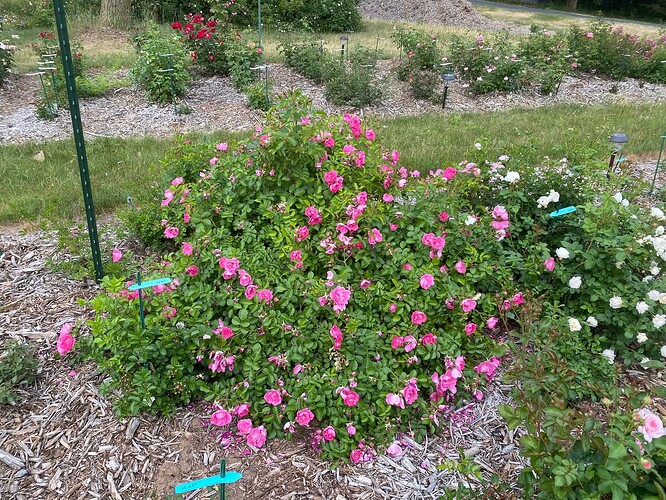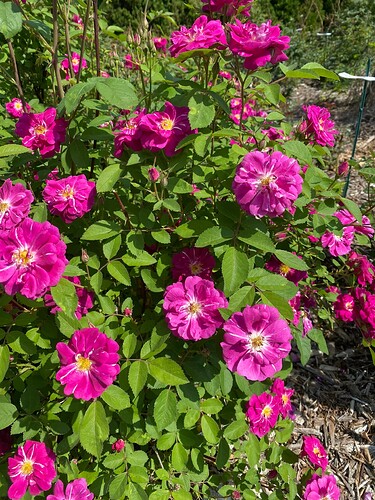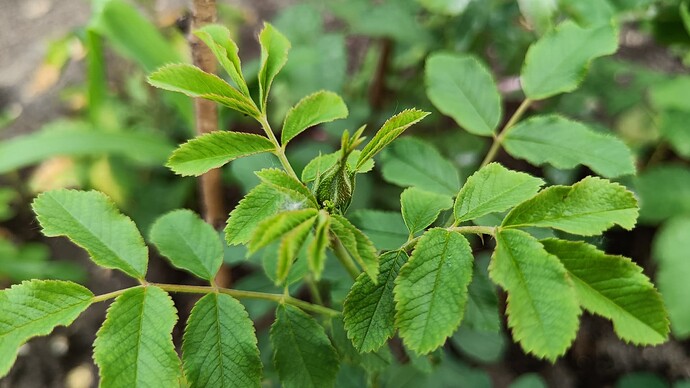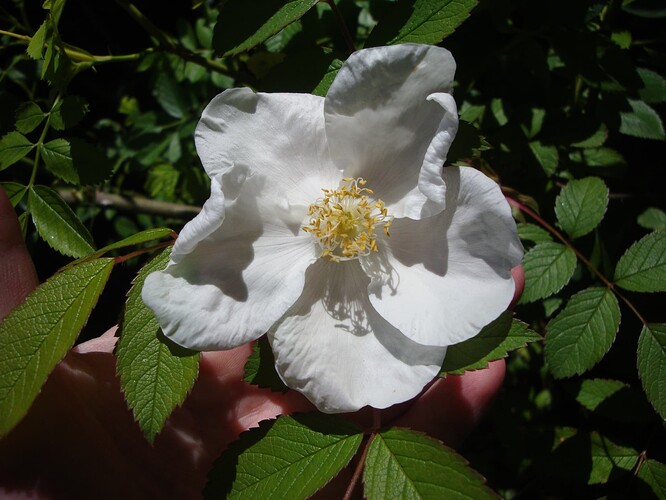Hi everyone,
Call me impatient but I would like to use rugosas that offer a decent percentage of juvenile blooming seedlings.
I added Will Alderman early this year, since I had read on this forum that he does have the genes for it. He’s still new so there were relatively few flowers to work with this spring, but a few took.
I can also say from my experiments last year that Jean de Luxembourg gave me 3/4 juvenile bloomers, but that one barely counts as a rugosa (at least in appearance, parentage being unknown).
I remember reading on another thread that someone had a few juvenile bloomers out of Snow Pavement, but it wasn’t clear what percentage of the seedlings showed this trait since the poster (sorry I don’t remember who) didn’t mention how many total seedlings they were growing from it. I do have that one but unfortunately every single hip I had on Snow Pavement this spring has shrivelled and yellowed. I’ll try again with her next blooms using different pollen, but she doesn’t seem very willing.
Does anyone have any recommendations for rugosa hybrids that give a good number of juvenile blooming offspring ?
I wonder about those rugosa hybrids that have teas or hybrid perpetuals as a rumored pollen parent, like Roseraie de L’Haÿ and Blanc Double de Coubert for example. Are those more likely to pass on juvenile bloom?
Hi SeasideRooftop!
In my experience, these roses tend to be sterile in both ways or at least have reduced fertility. Therefore it is recommended to use them rather as pollen parent, as you already mentioned. This way something is more likely to succeed.Unfortunately, I don’t have the ultimate tip yet either. I’m trying things out myself.
But I have got the information of several rose nurseries that Roseraie de L’Haÿ sets hips very-very sparsely. Parfum de l’Hay is much more suitable as seed parent too and is basically able to set hips. I tried Blanc Double de Coubert as seed parent and pollen parent so far with no success. Just for information, Rosen Schultheis indicates her parents as Rosa rugosa x ‘Sombreuil’.
The influence of rosa chinensis, which was supposed to provide a faster onset of flowering, probably often caused problems of the chromosome matching like Mrs Antony Waterer - Rosen online kaufen im Rosenhof Schultheis – Rosen online kaufen im Rosenhof Schultheis and Mme Tiret,'Madame Tiret' Rose or sometimes simply more patience is required.
Thank you for your reply Roseus!
In my garden, Roseraie de L’Haÿ produces at least one or two OP hips during the spring flush every year. I have always cut these off while deadheading, but I did check inside and there were a few seeds developing. So I can confirm the nursery reports that while her seed fertility is not great, there seems to be some. I haven’t used her for crosses yet so I don’t know if she’d give any juvenile bloomers. Maybe that can be a project for next year.
I am currently trying to make crosses onto Blanc Double de Coubert due to the reported Sombreuil ancestry, but no takes so far. That one has never set an OP hip here, so I know the odds are very low, but I still want to give it a try. There is Souvenir de Philémon Cochet after all, so it must be possible.
Thank you for the suggestions of Mrs Anthony Waterer and Mme Tiret. Those two do have interesting lineage!
In a similar vein I have a couple of nice hips developing from crosses I made on Souvenir de Yeddo, that one also has China blood, so I am hoping there will be at least a few juvenile bloomers in the lot.
I understand from reading this forum’s archive that rugosa hybrids with China blood can come with health issues. So far however all of the rugosa hybrids I grow have been healthy here aside from sporadic outbreaks of mildew, which usually resolve quickly.
I wish I had room to grow dozens of OP rugosa seedlings just to find out which ones can give the most juvenile blooming seedlings while still retaining a rugosa appearance, but I just don’t. So any experience from forum members is be very valuable.
It’s very similar for me, too.
Sorry, maybe I had expressed myself in a misleading way. These two rugosa hybrids should be simply other examples for nice roses and an interesting lineage but with very low fertility. Both are not able to set hips and are slim pollen dispensers. It is ultimately also a question of space.
My researches and testings must therefore continue.I’ll report back when I’ve made a convincing capture.
Much success for you!
Unfortunately, this is also true according to my experience. But there are some exceptions. Of course, this is also a question of space and selection. The development time sometimes takes longer to be able to do an ultimately judge of the seedlings in this regard.
I do get some juvenile bloom in some seedlings with ‘Therese Bugnet’, but it isn’t a pure rugosa. It crosses readily with pure rugosas though. When I’ve gotten a juvenile bloom out of more standard rugosa backgrounds, it has been after many many more leaves on the seedling before a bud is set than typical juvenile bloomers (at least 20 leaves first before the flower in rugosa seedlings that bloom precociously). At least with rugosa / polyantha hybrids I’ve gotten much better seed set and germination with the rugosa as the female. Many have been confused though and grow awkwardly. Attached is a poly rugosa hybrid with the poly as the female.
This is a poly x ‘Therese Bugnet’ that had juvenile bloom and blooms freely (it is ‘Catherine Guelda’).
I’ve tried TB as seed parent last year. About 6 different pollen parents. All would have some link with Rugosa. Only Gipsy Boy made her set a hip. I’ve one seedling (two died, “water sickness”). It is a sick little thing. I keep it out of interest. Who knows it’ll maybe grow a spine and overcome. Start growing.
This year my first cross was TB x Dortmund. A Kordesii. 5 flowers pollinated. She aborted them all in weeks. I don’t think she likes Kordesii as a pollinator. Last year few pollinators were Kordesii.
On the other hand. I had 8 seedlings of Schneezwerg x TB. I’ve kept 4 that didn’t get mildew. All juvenile bloomers are flowering. These seedlings don’t unfortunately.
Schneezwerg is also very fickle when it comes to pollinators.
That is a very beautiful rose
After that second list of ksnCopia roses came out, which had Roseraie de L’Haÿ as having a copy of the gene, I grabbed a bunch of hips from a public garden. There wasn’t a huge number (less than 10 among a couple shrubs) but they did have seed in them…I don’t think any of them have germinated so far though, still might though. Maybe it’d work better when intentionally pollinated or using it’s pollen.
That is fantastic, thank you for your feedback David!
Those two seedlings are very beautiful.
I’m curious, when you say “some” juvenile bloom, would you say that’s one in ten, one in a hundred, or even less?
Either way it’s very useful to learn that TB potentially might have some juvenile bloom genes. Thanks!
It is a challenge to find acceptable pollen parents for them, and so frustrating when it looks like a take and then they abort mid-way. I guess the rose knows something we don’t and on the plus side it’s probably sparing us from processing seeds that will never germinate, or if they did would only produce sickly seedlings. I hope your TB× Gypsy Boy seedling will manage to gather some strength!
Thanks so much for your feedback on Rdl’H! I hadn’t seen that list with the ksncopia , I will search the forum. If she indeed does have the gene, I will definitely be giving her a try. I hope those seeds will end up germinating for you!
It’s in the “Supplementary Data” (towards the bottom, there’s a link to download)
in “Supplementary Data Tables.xlsx” file on tab “Table D6”
Thank you very much Plazbo!
I was checking these seedlings and one has a flower ready. Jus saw it this evening. So 1 in 4 so far has juvenile bloom.
Thank you KarelBvn! Those numbers are very good, higher than I expected.
Even if there had been no juvenile bloomers among the mildewed ones, one in eight would still be pretty good. Thanks for sharing!
Blanc wasn’t a willing seed parent for me: I finally got a couple of hips with just a few seeds.
Only two germinations, both which died in first season. I was attempting cross with modern shrubs that were not as cold hardy, so perhaps too wide of crosses.
I also had repeat blooming seedlings with Therese Bugnet as seed parent (perhaps one in ten or a bit less, but not many).
Also Martin Frobisher (as seed parent) gave juvenile blooming seedling.
I realize neither of these are more traditional rugosas, but those are the only two I have received juvenile bloom from.
Not counting Rugelda (as it is so far removed, even more so, from Rugosa) but does make a good seed parent.
Duaen
Just on Roseraie de L’Haÿ that I mentioned collecting seed from a public park. They’ve started germinating ~7 months since harvest but probably ~5 months since sowing. I assume the delay is probably due to how ripe they were (almost soggy at harvest) given rugosa from my garden didn’t have such a long delay.
unlikely these will be juvenile blooming (despite it’s KSNcopia gene) unless pollinated by nearby mutabilis (or bee’s took long journeys) given just other rugosa around it as seen on the google street view (Roseraie de L’Haÿ is on the left of the path)
Despite how few hips there were among the several plants, the hips had typical rugosa seed numbers and germination seems to be decent so fingers crossed. It’d be kind of funny if a source of relative ease for rugosa juvenile bloom was in front of everyone all along.
Thanks for sharing your update, @Plazbo !
I will be looking forward to hearing more about these seedlings as they grow!
I made only very limited pollination attempts on Rdl’H late in the spring, which failed, and since then she has gone to sleep for the hottest part of the summer. I am seeing signs that she may be starting to wake up now, so I am definitely going to try her again when she blooms.
Rdl’H has surprisingly few descendants considering how long she’s been around and how widely available she is. I guess she got overshadowed by Hansa? It would indeed be great if this rose turned out to be a good source of juvenile bloom. Best wishes for your seedlings!
I can’t for the life of me now remember just how quickly two relatively precocious seedlings from a cross between R. rugosa ‘Alba’ and ‘Mutabilis’ flowered, but I know that their siblings showed very delayed flowering, so I would say that they were at least semi-juvenile in their flowering behavior. One had beautiful, warm coppery-pink flowers (I believe it eventually died from one too many cane borer attacks), while the other is nearly white, but also with attractive flowers. That seedling is surprisingly forming at least one OP hip as we speak, in spite of the chlorotic protest of its still-containerized condition, and is making me think that I should probably find a place to plant it.
Stefan



